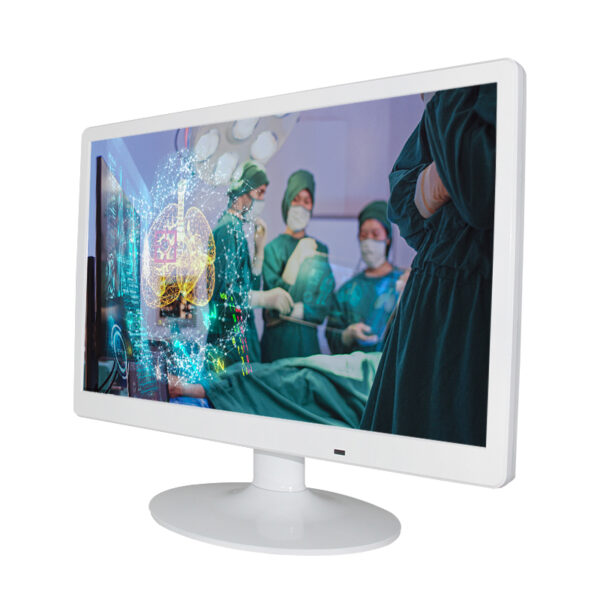
As technology continues to advance, the healthcare industry has also been revolutionized in various ways. One of the most significant changes that have occurred is the introduction of white medical monitors. These monitors are 21.5-inch displays that are specifically designed for medical professionals to help them provide better care for their patients.
In this article, we will explore the various benefits of using white medical monitors in the healthcare industry and how they have transformed the way medical professionals work.
What are White Medical Monitors?
White medical monitors are 21.5-inch displays that have been designed for use in medical settings. They are specifically created to provide medical professionals with the best possible image quality and accuracy when viewing medical images such as X-rays, CT scans, and MRIs.
White medical monitors are different from regular computer monitors because they are designed to display images in a specific color range. They have a higher contrast ratio, which means that they can display images with greater detail and accuracy. They also have a wider viewing angle, so medical professionals can see the images from different angles without losing clarity.
The Benefits of White Medical Monitors
There are numerous benefits to using white medical monitors in the healthcare industry. Some of these benefits include:
- Accurate Image Display
One of the most significant benefits of white medical monitors is their ability to display medical images accurately. Medical images need to be displayed with great precision to ensure that medical professionals can accurately diagnose and treat their patients. White medical monitors are specifically designed to provide clear, sharp images with the highest possible accuracy.
- Improved Image Quality
White medical monitors have a higher contrast ratio and a wider viewing angle, which means that medical professionals can view images with greater detail and accuracy. This improved image quality means that medical professionals can better see and analyze the medical images they are viewing.
- Improved Productivity
White medical monitors are designed to be user-friendly and easy to use. Medical professionals can easily navigate through images and data, making it faster and more efficient to diagnose and treat patients. This increased productivity means that medical professionals can see more patients and provide better care.
- Reduced Eye Strain
Medical professionals spend a lot of time looking at medical images, which can be taxing on their eyes. White medical monitors are designed to reduce eye strain by providing a clearer, sharper image with less glare. This means that medical professionals can work for longer periods without experiencing eye fatigue.
- Compliance with Regulatory Requirements
Medical images are sensitive and require strict regulatory compliance. White medical monitors are designed to meet these regulatory requirements, making them a reliable and safe choice for displaying medical images.
- Longevity
White medical monitors are designed to last a long time, making them a cost-effective investment for medical facilities. They are built to withstand the rigorous demands of medical work, and their high-quality components ensure that they can perform at a high level for years.
How White Medical Monitors are Used
White medical monitors are used in a variety of healthcare settings, including hospitals, clinics, and private practices. They are used by radiologists, oncologists, and other medical professionals who need to view medical images as part of their job.
White medical monitors are used to view a range of medical images, including X-rays, CT scans, and MRIs. They are also used to view ultrasound images, which require a high level of image quality to ensure accurate diagnosis and treatment.
White medical monitors are typically connected to a medical computer or workstation. Medical professionals can then access the images they need and navigate through them using specialized software.
Conclusion
White medical monitors have transformed the way medical professionals view and analyze medical images. Their high-quality components, accurate image display, and improved productivity have made them an essential tool in the healthcare industry. They are a cost-effective investment for medical facilities, and their longevity ensures that they can

The color temperature of medical displays is generally not warm, but rather neutral or cool. The color temperature of a display refers to the color of the light emitted by the display, and it is measured in degrees Kelvin (K).
A warm color temperature has a reddish-yellowish tint, while a cool color temperature has a blueish tint. Neutral color temperature, on the other hand, has no strong color cast and appears to be more balanced.
In medical displays, a neutral or cool color temperature is preferred because it provides a more accurate representation of the colors in medical images. This is because medical images are typically captured under specific lighting conditions, and it is essential that the display reproduces those colors accurately.
For example, when viewing medical images such as X-rays, CT scans, and MRIs, it is important that the colors of the images are accurately displayed. If the colors are inaccurate, it could lead to misinterpretation of the medical images, which could result in incorrect diagnoses and treatment.
Medical displays are typically calibrated to a neutral or cool color temperature, and this calibration is regularly checked to ensure that the display is displaying colors accurately.
However, it is worth noting that some medical displays may have adjustable color temperature settings. Medical professionals can adjust the color temperature to suit their preferences, but it is important to ensure that the display is still accurately displaying colors.
In conclusion, the color temperature of medical displays is generally not warm, but rather neutral or cool. This is because a neutral or cool color temperature provides a more accurate representation of the colors in medical images, which is essential for accurate diagnosis and treatment.


